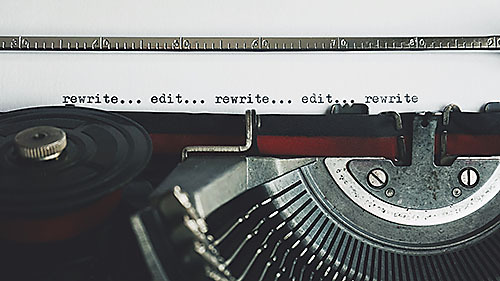I want you to think back to your high school English classes. What was your biggest takeaway from those four years? For me, it was the basic writing process: find your topic, research it, organize your notes, create an outline, write a rough draft, revise it, proofread it, and submit. Every paper I wrote used this method.
My senior year, everything I learned about this process changed when my AP English teacher introduced us to a different way of thinking about revision. He argued that the writing process we had been taught underestimated the value of revision and its importance in the writing process. Writing should be 70 percent revision, 25 percent writing, and the rest minor editing. Writers should constantly be revising their work—looking at their work with fresh eyes and reimagining it until it reaches its full potential.
Writing has always been stressful for me, but this new mindset helped take away a lot of the pressure because it meant that I didn’t have to have everything written—I could start with the most critical elements and come back to it later. It revolutionized my writing process and I became a better writer because of it.
By the time I finished my bachelor’s degree, I had developed my own personal writing style that focused on revising my work in multiple rounds. It was a blend of everything I had been taught about writing and the “correct” processes. I thought I was set when it came to my writing and that this process would be my method for life.
Within two weeks of starting my master’s program, my writing world once again imploded on itself. While learning about the different stages of the editing process, I learned that revising is not actually revision—it’s the standard editing process.
Go back to high school English again, this time concentrating on what you were taught to look for when revising: big picture errors like inconsistencies in plot, character development, organization, and flow. In my own process, I reread my paper looking for inconsistencies, reorganizing sentences and paragraphs, and joining sentences together. In the editing world we call this developmental editing.
When we were asked to proofread our papers and look for errors in grammar, tone, verb tense, syntax, and voice, I obsessed over every word, every sentence, and every paragraph. I was line and copyediting without realizing it. The final read-through before turning in our papers is proofreading and typesetting.
Putting these pieces together blew my mind. But it makes sense when you take a step back and think about it in terms of the endgame. Editors want to ensure that a manuscript is the absolute best it can be so that it will be picked up by publishers and distributed into the world; authors have this same goal: to be published and get their work out there. In high school, and even in college, we wanted our work to be good enough to be accepted and approved by our teachers. The shared goal is to be accepted, and to be told that we produced quality work.
I wish I had learned about the connection between editing and revising sooner. I fell in love with revision and realized that my passion is in helping other writers create their best work. Revising helped me realize that I want to work in the publishing industry; I just wish these connections were made clearer in high school. I would have realized my passion much sooner.

